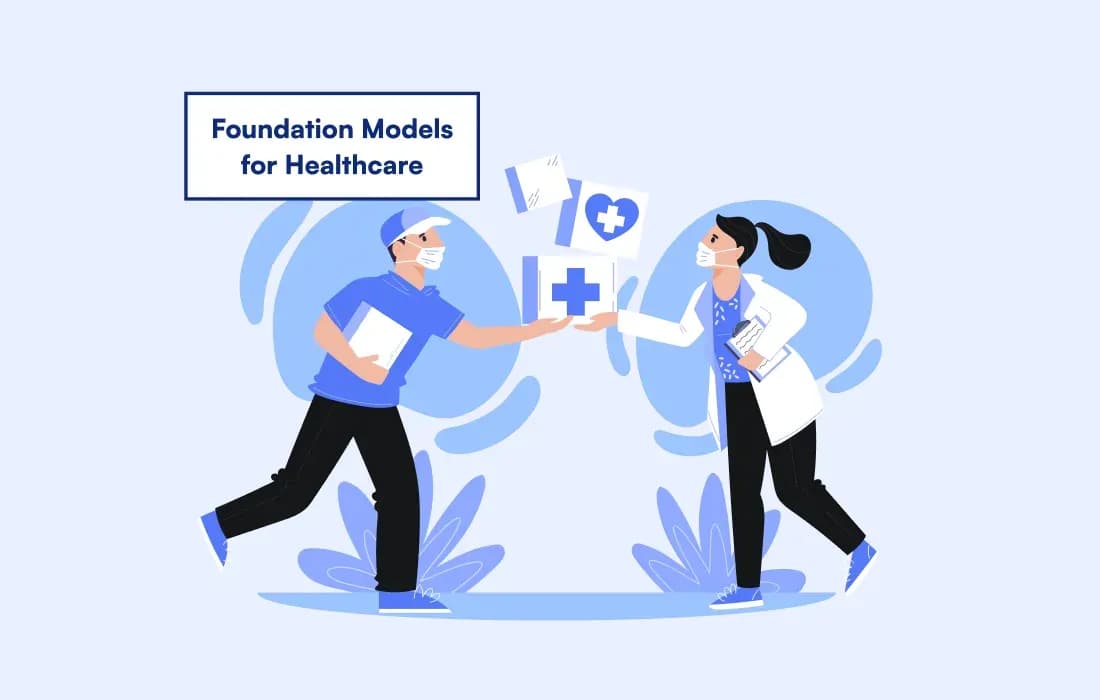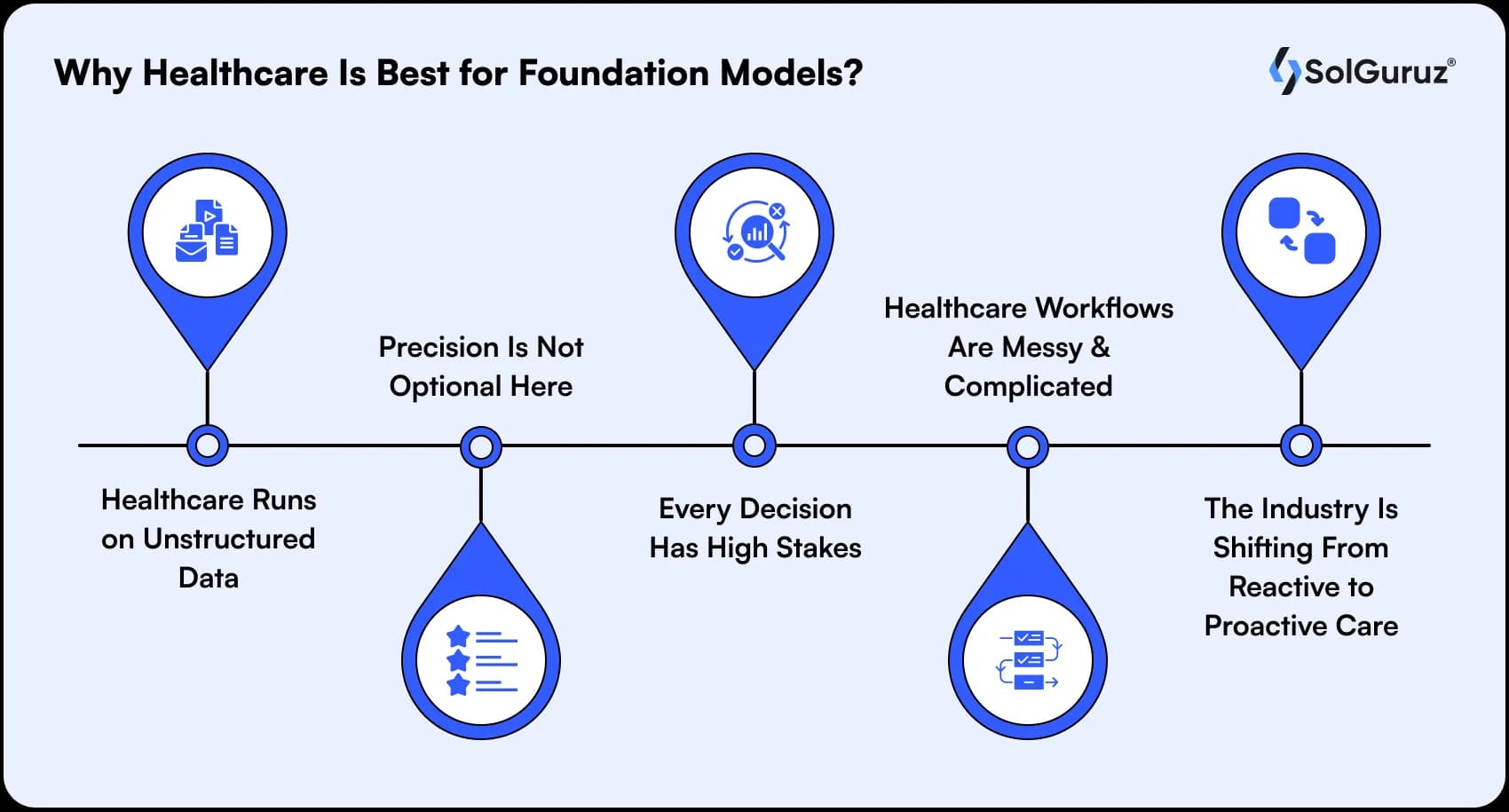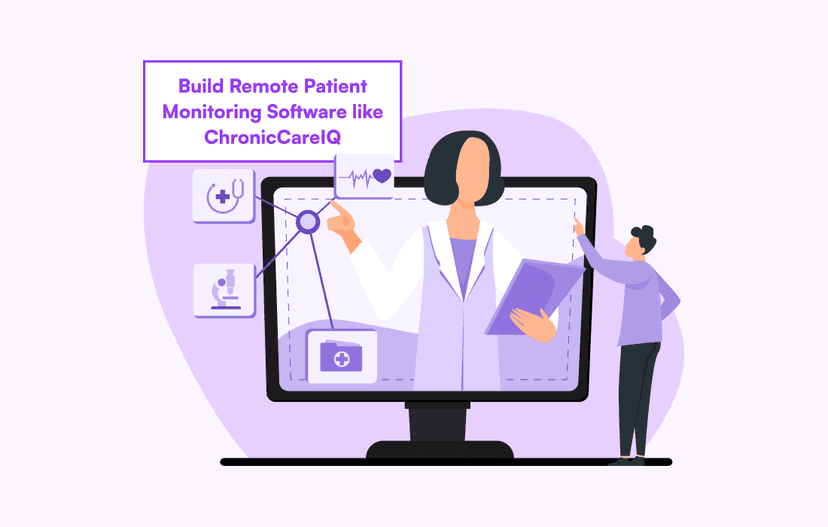Foundation Models for Healthcare: 2026 Guide & Use Cases
Learn how healthcare teams can use foundation models safely and effectively. Explore use cases, clinical integration, compliance risks, deployment steps, and how SolGuruz helps teams fine-tune and scale AI across real workflows.

The last two years have been overwhelming for the healthcare industry.
Why? Because there is a crazy level of adoption of foundation models.
Earlier, they were simply an experimental research tool. Now, they are actually used to do tasks like read medical images, patient histories, and stuff.
The shift is big, and every healthcare leader is paying attention.
But here is the bottleneck. Foundation models are not magic items that can be used on a whim. It comes with risks and benefits.
So what should you do?
Pretty simple, get a deep insight into what foundation models are, and how they affect the healthcare industry. And it will help you make informed decisions.
This blog will tell you how these models work, where they are useful, and when to be cautious.
I will also share some ideas on how you can use these models in your current systems. So stay tuned!
Table of Contents
What are Foundation Models?
See, foundation models are nothing but the “general intelligence layer” of modern AI.
Instead of being trained to do one narrow task, they are trained on massive amounts of diverse data. For instance: medical literature, clinical notes, and more.
Because of this broad training, these models develop an understanding of patterns. Which traditional machine learning models simply cannot.
And unlike older models, they are multi-modal. This means that they can process and understand different types of data.
All this together gives richer and more accurate insights.
Here is a simple comparison:
- Traditional ML: One model per task. Data-hungry. Limited context.
- Foundation Model: One model, many tasks. It learns patterns at scale. also adapts to new scenarios with minimal additional training.
That is why you see them powering everything from diagnostic assistants to drug discovery tools.
They serve as a “base model”. And you can fine-tune them for your exact use case.
Why Healthcare Is Best for Foundation Models?

See, healthcare has always struggled with a paradox.
It produces more data than almost any other industry, yet most of that data stays underutilized.
Foundation models change that equation.
1. Healthcare Runs on Unstructured Data
Nearly 80% of healthcare-related data goes unused. Like lab reports and discharge summaries.
And traditional ML models do not fit here. For Foundation models, this is like a home ground.
2. Precision Is Not Optional Here
A financial model can afford a 2% error margin.
A diagnostic assistant cannot.
Foundation models, with their ability to understand context and nuance, offer dramatically better accuracy in complex decision-making tasks.
3. Every Decision Has High Stakes
Diagnoses, treatment plans, and medication recommendations. Every mistake impacts patients.
That is why healthcare rewards models that can interpret, reason, and explain.
4. Healthcare Workflows Are Messy and Complicated
From intake to coding to claims, processes are fragmented.
Foundation models can automate or augment parts of these workflows because they are multi-modal and adaptable.
5. The Industry Is Shifting From Reactive to Proactive Care
Prediction, prevention, and personalization are becoming the new standards.
Foundation models are built exactly for this: analyzing patterns at scale and spotting things humans miss.
Prime Use Cases of Foundation Models in Healthcare

Foundation models work because they can handle multiple data types. Plus, they apply contextual understanding across tasks.
Here is where they are already creating value:
1. Clinical Decision Support
This is where foundation models work the best. They can analyze multiple data sources and help clinicians make more accurate decisions.
Practical use cases:
- Interpreting X-rays, MRIs, and CT scans
- Assisting doctors with diagnosis and differential diagnosis
- Prioritizing urgent cases with intelligent triage
- Recommending personalized treatment paths
The best part? In these use cases, you will not be running multiple models for each task. You will get a single model that understands context end-to-end.
2. Medical Research & Drug Discovery
Healthcare research is dense, slow, and costly. Foundation models speed it up by acting as a “super research assistant.”
Practical use cases:
- Predicting protein structures
- Generating potential drug molecules
- Summarizing thousands of scientific papers
- Understanding complex genomic patterns
This means researchers spend less time reading and more time experimenting.
3. Workflow Automation & Documentation
Clinician burnout is real. Foundation models help by removing repetitive administrative tasks.
Practical use cases:
- Generating clinical notes automatically during patient consultations
- Summarizing long patient histories
- Structuring information for EHR systems
- Automating prior authorizations and claim validation
This does not just save time. It reduces errors and improves accuracy.
4. Patient Support & Engagement
From scheduling to follow-ups, foundation models improve communication without overloading clinical staff.
Practical use cases:
- AI-powered virtual assistants for routine queries
- Intelligent chat systems for symptom screening
- Medication reminders and post-care instructions
- Personalized wellness insights based on patient data
This brings patient experience to the next level.
5. Population Health & Public Health Intelligence
When you zoom out, foundation models can help analyze large datasets across entire populations.
Practical use cases:
- Predicting disease outbreaks
- Identifying risk factors across demographics
- Supporting epidemiological research
- Optimizing resource planning during crises
This is the beginning of proactive, population-level healthcare.
Examples of Foundation Models Already Transforming Healthcare

I know it all sounds good until you actually do it. So, here are some examples of foundation models that have impacted healthcare significantly.
1. Med-PaLM (Google DeepMind)
Med-PaLM was trained specifically on medical data and clinical knowledge.
It performed exceptionally well in medical exams and is being tested in hospital environments to assist with diagnosis, clinical reasoning, and medical Q&A.
It shows how domain-specific tuning turns a general model into a powerful clinical assistant.
2. BioGPT (Microsoft + OpenAI ecosystem)
BioGPT is simply designed for biomedical text generation and literature analysis.
It reads and summarizes research papers and identifies relationships between genes and diseases. This helps you give a solid boost to scientific discovery.
Researchers do not need to manually read thousands of papers to extract insights.
3. NVIDIA Clara
Clara is built for medical imaging, genomics, and smart hospital solutions.
Hospitals use it to fasten the radiology workflows and power AI-assisted imaging tools.
It blends multi-modal capabilities (like text and images) under one platform.
4. GPT-4/5-based Healthcare Assistants
Large general models like GPT 4 & 5 are being used to create systems like diagnostic assistants and decision-support tools.
These models show how flexible foundation models can be when integrated with healthcare-specific data and workflows.
5. HuggingFace Healthcare Models
The open-source community is pushing innovation forward with models trained on clinical notes, radiology reports, and genomics datasets.
Startups and smaller healthcare systems can experiment without massive budgets.
How to Integrate Foundation Models into Healthcare Systems

Bringing foundation models into healthcare is not about “plug and play.”
It is a strategic process that balances tech and outcomes.
And here is a clear roadmap that teams can actually follow:
1. Start with a Clear Use Case (Do Not Start with the Model)
Before touching a single API, define the problem:
- Are you speeding up diagnosis?
- Automating clinical notes?
- Assisting research teams?
- Reducing administrative overhead?
A focused use case reduces cost, complexity, and compliance risk.
2. Validate Regulatory Requirements Early
Healthcare comes with strict compliance boundaries. Based on your target market, you need to think about:
- HIPAA
- GDPR
- FDA/CE approvals (for clinical tools)
- Local data residency laws
- Audit trails and explainability
Skipping this step guarantees delays later.
3. Build a Secure Data Pipeline
Foundation models are only as good as the data they can access. Construct a secure pipeline that includes:
- Data cleaning
- De-identification/anonymization
- Encryption
- Controlled access
- Role-based permissions
This ensures privacy without killing performance.
4. Choose the Right Model Architecture
Your choices:
- Off-the-shelf model: Fastest way to prototype, good for admin tasks.
- Fine-tuned model: Best for clinical accuracy and domain-specific workflows.
- Fully custom model: Expensive but powerful. Only works when you have massive proprietary datasets.
You need to choose this based on your use case and data availability.
5. Fine-Tune with Domain-Specific Data
Even a great foundation model will not understand the nuances of your hospital or research data by default.
- Use your clinical notes
- Imaging data
- Pathology reports
- EHR exports
- Research documentation
All this will ensure that the model works smarter in your custom environment.
6. Integrate With Existing Systems
This is often the hardest part.
The thing is, your model must talk to systems like:
- Epic
- Cerner
- PACS
- DICOM viewers
- HIS/LIS/EHR modules
For this, you need to use APIs and middleware to ensure smooth data flow without disruption.
7. Implement Human-in-the-Loop Review
See, for clinical tasks, full automation is not realistic.
Instead, let clinicians review, validate, and correct outputs.
This offers:
- Safety
- Trust
- Continuous improvement
Your model gets smarter with every interaction.
8. Set Up Monitoring and Retraining Pipelines
Models degrade over time. To stay accurate, you need:
- Performance tracking
- Bias monitoring
- Periodic retraining
- Error detection
- Feedback loops
This actually helps you transform your AI from a one-time project into a continuously improving asset.
9. Pilot First. Scale Later.
Run a controlled pilot:
- 1 department
- 1 workflow
- 1 hospital unit
Validate ROI, safety, and adoption before expanding.
Challenges & Risks You Must Consider

Foundation models can do a lot for healthcare. Period. But you need to be aware of the risks before deciding on anything.
Here are the major challenges you must be aware of:
1. Data Privacy & Compliance
Healthcare data is extremely sensitive.
Any AI system touching patient information must follow local privacy laws.
A single misstep can lead to legal issues.
2. Incorrect or “Hallucinated” Outputs
Foundation models sometimes produce answers that sound confident but are wrong.
In clinical situations, that is dangerous.
You need human review as a part of the workflow.
3. Bias in Training Data
If the model was not trained on diverse data, it may perform poorly for certain edge cases.
This can create unfair and inaccurate results. This cannot work in the healthcare industry.
4. Lack of Explainability
Doctors need to know why a system suggested something.
Foundation models often act like black boxes, making trust a challenge.
5. Integration Roadblocks
Most hospitals use legacy systems.
Connecting AI to existing systems or lab databases can be messy and time-consuming.
6. Cost & Infrastructure Needs
Running large models can get expensive. Especially when you add storage, GPUs, and ongoing monitoring.
Teams also often face unexpected GPU cost overruns when scaling pilots to production without optimizing usage.
Teams often underestimate the long-term costs.
7. AI Liability Risk
If a model produces a wrong prediction or recommendation, who’s responsible? The hospital, the vendor, or the model provider?
Liability in AI-driven clinical systems is still a gray area, and ignoring it can lead to serious legal exposure.
Always make sure that you define accountability before deployment.
8. Adoption & Training
Even if the system works well, clinicians may resist it if it disrupts their workflow. It is in human nature to avoid extra work.
To avoid this, you can have a gradual rollout and a preset training regimen.
Build vs. Buy: What Is the Right Approach for You?
The biggest question teams face is whether to build their own foundation model setup or use an existing one.
Here is what I usually suggest:
1. When to Use Off-the-Shelf Models
If your goal is to automate administrative or workflow tasks, pre-trained models are usually enough.
This works best for documentation, summarization, or patient communication.
Pros:
- Fast to get started
- Lower cost
- Good for prototyping
- Easy integration through APIs
Cons:
- Limited control
- Not fine-tuned for your clinical context
Use this when: Speed matters more than depth.
2. When to Fine-Tune a Foundation Model
If you are working on clinical tasks, you will need custom fine-tuning.
Pros:
- Higher accuracy
- Better domain understanding
- Customized for your workflows
Cons:
- Requires quality data
- Higher cost than plug-and-play
Use this when: You want high performance in a specific domain.
3. When to Build from Scratch
This is the rarest option. Only consider building a fully custom model if you:
- Have massive, proprietary datasets
- Need a strict on-premise deployment
- Need ultra-specific model behavior
Pros:
- Maximum control
- Fully compliant and private
- Tailored performance
Cons:
- Extremely expensive
- Time-consuming
- Requires strong in-house AI talent
Use this when: You are a large healthcare organization or research institute with unique requirements.
How SolGuruz Helps Healthcare Teams Implement Foundation Models
We have seen the excitement (and confusion) around foundation models up close.
Teams want to use AI, but most get stuck somewhere between “proof of concept” and actual impact.
At SolGuruz, we have helped healthcare startups and enterprises move past that gap.
If you want to bring AI into your healthcare ecosystem, we will help you do it the right way.
FAQs
1. Are foundation models safe for clinical use?
They can be, but only when done properly. Because in healthcare, these models must go through strict accuracy checks before being used in clinical workflows.
2. Can smaller healthcare startups use foundation models too?
Absolutely. You do not need to build your own model. Many startups use open-source or API-based models and fine-tune them for their niche. It is faster, cost-effective, and easier to scale.
3. How do foundation models handle patient data?
By design, they do not “store” or “remember” individual patient data. However, privacy depends on how you deploy them. That is why compliance and proper data pipelines are critical before implementation.
4. How do foundation models compare to traditional ML models?
Traditional models perform one task well. On the other hand, foundation models can handle many. This is because they understand context across multiple data types.
5. How can SolGuruz help my team get started?
We help you identify use cases that actually move the needle. Like we can, fine-tune your existing foundation models. That too, without breaking compliance or performance.
Bring Foundation Models to the Healthcare System
We will help you design, deploy, and scale AI responsibly.

Strict NDA

Trusted by Startups & Enterprises Worldwide

Flexible Engagement Models

1 Week Risk-Free Trial
Give us a call now!

+1 (724) 577-7737


